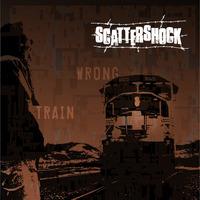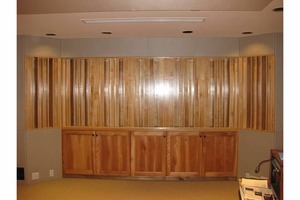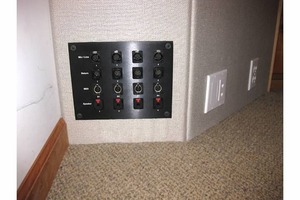Scattershock - Recording "Wrong Train": Part 1
 A few months ago, I explained the history of my partnership with Steve Rosenthal, and how we eventually recorded 14 songs at Rocky Mountain Recorders in Denver, with help from engineer, Gannon Kashiwa, and bass player, Paul Olguin. You can find the two earlier articles here (Scattershock - A History: Part 1, Part 2). In this article I will describe the long path that followed before any of those tracks were released.
A few months ago, I explained the history of my partnership with Steve Rosenthal, and how we eventually recorded 14 songs at Rocky Mountain Recorders in Denver, with help from engineer, Gannon Kashiwa, and bass player, Paul Olguin. You can find the two earlier articles here (Scattershock - A History: Part 1, Part 2). In this article I will describe the long path that followed before any of those tracks were released.
Sometime in 2006 or 2007, while I was working at Apple and after I'd finally gotten my Redwood City recording studio fully functional, Steve and I decided it was time to put Pro Tools and our analog gear through its paces. We'd always felt that the early Pro Tools recordings we'd done of all the Shatterbox material hadn't had the energy or polish we wanted, and decided that those sessions were the perfect opportunity to experiment with processing and mixing. We started by patching various pieces of analog gear into inserts in Pro Tools, running drums, bass, guitar and vocals through all the outboard gear, learning which units sounded good on which tracks. After many nights of trial and error, we eventually established a collection of signal paths and settings that we liked. Using those, we reprinted all the Shatterbox audio tracks through our processing chains of choice.
The resulting analog-reprocessed tracks established our new baseline for mixing. Steve and I continued our weekly evenings together in the studio, using plug-ins to fine tune the tones and eventually established a collection of settings that could be used across all of the songs, with only small adjustments on a case-by-case basis. With that in place, we were able to focus on the mixes themselves and soon wrapped them up. To further exercise the analog and digital gear, we proceeded to master the songs, learning even more in the process.
 By the time we'd wrapped up all the mixing and mastering, we were excited about how good the songs sounded. The analog reprocessing had breathed fresh life into the songs and everything sounded so good that we wanted the rest of the world to hear it. Since Mike Levine had contributed to the collection as a songwriter, vocalist and bass player, we contacted him to let him know how excited we were and that we were interested in releasing them as an album. Steve and I had started Crayonmaster, the company that held the rights to our songs and would act as the music label for the release. We were happy to cover the legal and logistical costs of the release and wanted to split any proceeds equally between the three of us. Unfortunately, after a brief period of optimism, it became clear that Mike was unhappy with the plan. After a few more attempts to reach a compromise, Steve and I decided it was not going to work out.
By the time we'd wrapped up all the mixing and mastering, we were excited about how good the songs sounded. The analog reprocessing had breathed fresh life into the songs and everything sounded so good that we wanted the rest of the world to hear it. Since Mike Levine had contributed to the collection as a songwriter, vocalist and bass player, we contacted him to let him know how excited we were and that we were interested in releasing them as an album. Steve and I had started Crayonmaster, the company that held the rights to our songs and would act as the music label for the release. We were happy to cover the legal and logistical costs of the release and wanted to split any proceeds equally between the three of us. Unfortunately, after a brief period of optimism, it became clear that Mike was unhappy with the plan. After a few more attempts to reach a compromise, Steve and I decided it was not going to work out.
This marked one of the most painful, frustrating periods of my music career. Steve and I had spent years writing, tracking, mixing and remixing this collection of songs and now, just like that, the project was tabled. Fortunately, in the midst of the unhappiness, an idea was born. We remembered the Denver tracks and realized they provided us with a new opportunity. We were free to do whatever we wanted with those tracks and quickly established a new goal: finish enough of those songs to release an album anyway. While setting up Crayonmaster, we had discovered that another band had been formed with the name, "Shatterbox", and they had locked up domain names and social profiles with it. Thus, the name, "Scattershock", came to be.
Then began another round of recording and mixing. Although we were happy with all the performances from Denver, I was not satisfied with the tone I'd captured using my Soldano X99. Listening back years later it just didn't have the excitement or power that I wanted on our songs. It was fairly easy to make the decision to re-track my guitar parts, this time in my own studio and using my ENGL Powerball. We rolled up our sleeves again and proceeded to reprocess the drum and bass tracks using the analog gear and knowledge gleaned from the Shatterbox remixes. It took time but was quickly a source of satisfaction. The tracks came to life even more so than the Shatterbox tracks.
 As for the guitars, I hunkered down and started tracking them, with the Powerball cranked up and my trusty Sennheiser e906 up close and personal with my Marshall cabinet. I made some adjustments to the parts, aimed at establishing two distinct rhythm parts for each song. Typically, I tracked the first part with my Anderson Drop Top using my standard high gain, relatively bright, distorted tone. The second part varied more in tonality, but most often was tracked using my Anderson Hollow-T and a darker tone. To this day, I am happier with the Scattershock guitar tones than with any other project.
As for the guitars, I hunkered down and started tracking them, with the Powerball cranked up and my trusty Sennheiser e906 up close and personal with my Marshall cabinet. I made some adjustments to the parts, aimed at establishing two distinct rhythm parts for each song. Typically, I tracked the first part with my Anderson Drop Top using my standard high gain, relatively bright, distorted tone. The second part varied more in tonality, but most often was tracked using my Anderson Hollow-T and a darker tone. To this day, I am happier with the Scattershock guitar tones than with any other project.
Next time I will explain how we moved beyond rhythm tracks to vocal tracking, lead guitar, mixing and mastering.
 1 Comment → Posted on
1 Comment → Posted on  Monday, September 10, 2012 at 12:32PM
Monday, September 10, 2012 at 12:32PM
Reader Comments (1)
Would like to you talk to about joining a band out of whitehall. We are looking for a singer. We are a 3 piece band that originally was from the bay area. We do all original heavy/ hard rock taken from the 70s, 80s, 90s up to the present. If that was you singing then we are interested. We are in the same age group, some older. We would also welcome your guitar. If interested contact me at rrockk3@3rivers.net or Tony at 406-842-7512